Key takeaways:
- Storytelling in photography evokes emotions by capturing moments that connect with viewers through details, expressions, and context.
- Composition is crucial; techniques like the rule of thirds and negative space enhance narratives and invite viewer exploration.
- Capturing emotions effectively involves connecting with subjects, utilizing appropriate lighting, and seizing candid moments for authenticity.
- Analyzing photo stories reveals deeper meanings and emotional layers, while the sequence of images can create a compelling narrative arc.
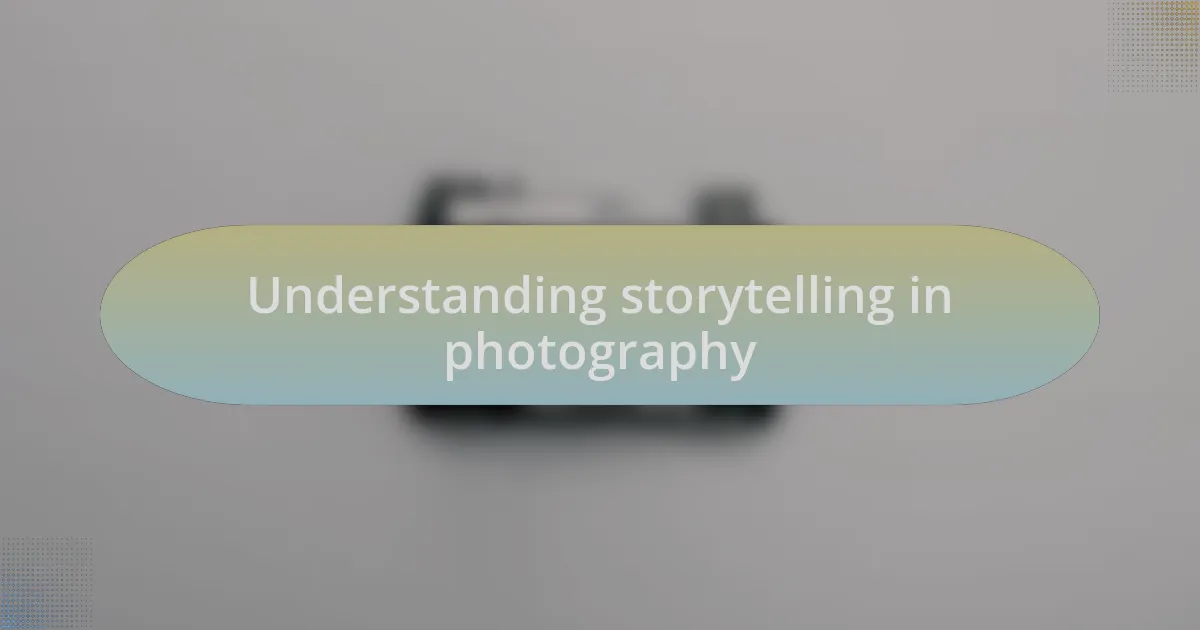
Understanding storytelling in photography
Storytelling in photography is all about evoking emotions and capturing moments that resonate with viewers. I remember the first time I snapped a candid shot of a child laughing in a park; it wasn’t just a picture of a joyful moment—it told a story of innocence and unfiltered happiness. How can a single image convey so much? It’s in the details, the expressions, and the context.
When I began exploring this art form, I realized that each photograph holds the potential for countless narratives. For instance, a portrait of an elderly person can reflect a lifetime of experiences, endings, and new beginnings. Have you ever looked at a photo and felt it speak to you? That’s the magic of storytelling in photography—it’s about connection and shared experiences.
The composition of an image, from light to shadow, plays a crucial role in enhancing the narrative. I once experimented with a sunset over a desolate landscape to symbolize solitude. The soft hues of orange and purple drew viewers into the atmosphere, making them ponder their own moments of loneliness. Through this, I learned that storytelling isn’t just what you capture but how you present it to provoke thought and emotion.
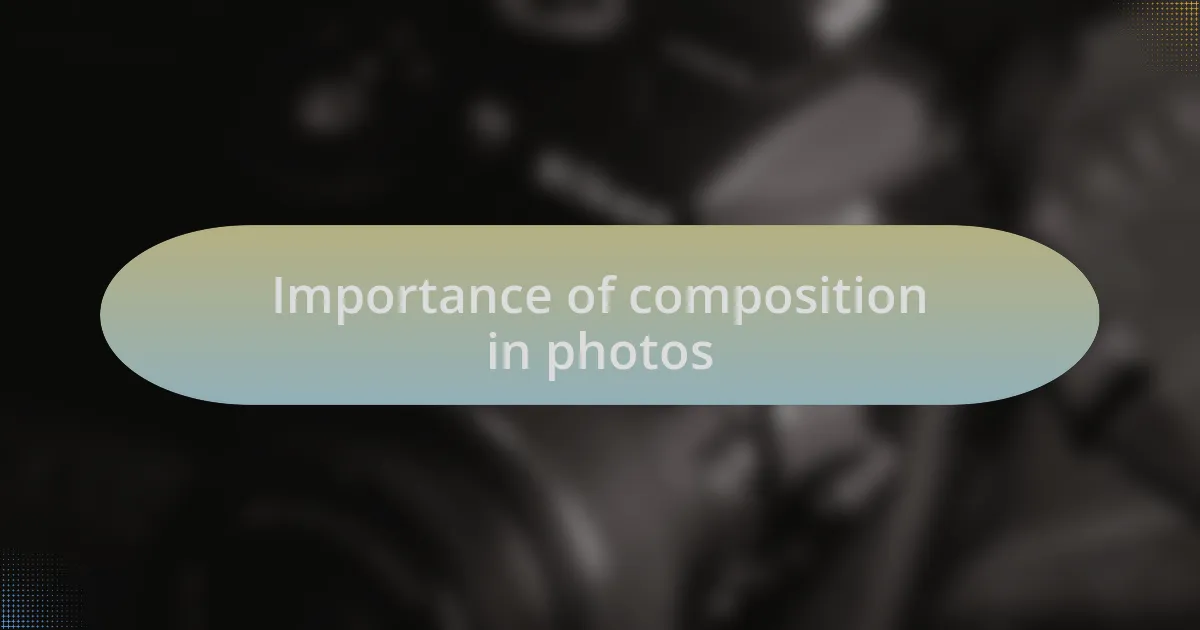
Importance of composition in photos
The arrangement of elements in a photograph can transform a simple scene into a compelling story. I recall taking a photo at a bustling market, where I carefully placed the vibrant fruits in the foreground, leading the viewer’s eye to a vendor interacting joyfully with customers in the background. Did you notice how the arrangement created layers? This deliberate composition invites the viewer to explore every part of the image, enriching the narrative.
When I first started, I often overlooked composition, thinking that capturing a moment was all that mattered. However, I learned that the rule of thirds—dividing the frame into a grid—could enhance the storytelling aspect of my photos exponentially. Placing points of interest along these lines not only balanced the image but also drew the viewer’s attention, making them feel more involved in the story.
I’ve also found that negative space can be a powerful tool in composition. There was a time when I photographed a lone tree in a vast field, emphasizing its isolation surrounded by empty space. This choice evoked a sense of solitude and introspection, prompting viewers to reflect on their own feelings of being alone. Have you considered how negative space can shape the emotions conveyed in your work? It’s a technique that can speak volumes beyond words.
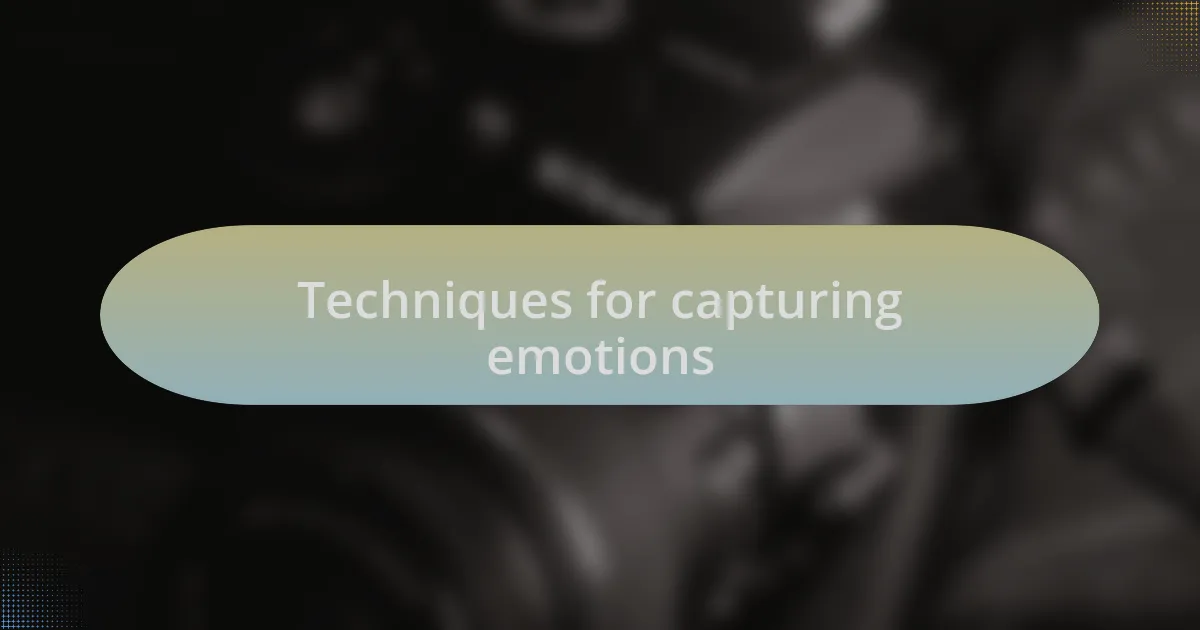
Techniques for capturing emotions
Capturing emotions in photography often hinges on the ability to connect with your subject. I remember once photographing a child at a birthday party, laughter erupting all around. Instead of just shooting from a distance, I knelt to her level, framing her joyful expression among the chaos of balloons and cake. This choice drew the viewer into that moment of sheer happiness, allowing them to relive the excitement through her eyes.
Lighting can dramatically influence the emotion a photograph conveys. One evening, I took a spontaneous shot of a friend as the sun began to set. The warm glow cast a soft, golden hue over her face, highlighting the tears she was holding back during a moment of reflection. The contrast between light and shadow not only added depth to the image but also captured an intimate vulnerability that words would fail to express. Have you ever considered how different lighting conditions might transform the feeling of your photos?
Another effective technique is capturing candid moments, where the true essence of emotion often unfolds. I once snapped a photo of an elderly couple holding hands while watching their grandchildren play. Their smiles were genuine, reflecting years of love and companionship. This unscripted moment revealed the kind of deep connection that posed portraits often miss. Isn’t it intriguing how the most powerful emotions come alive when we allow life to unfold naturally?
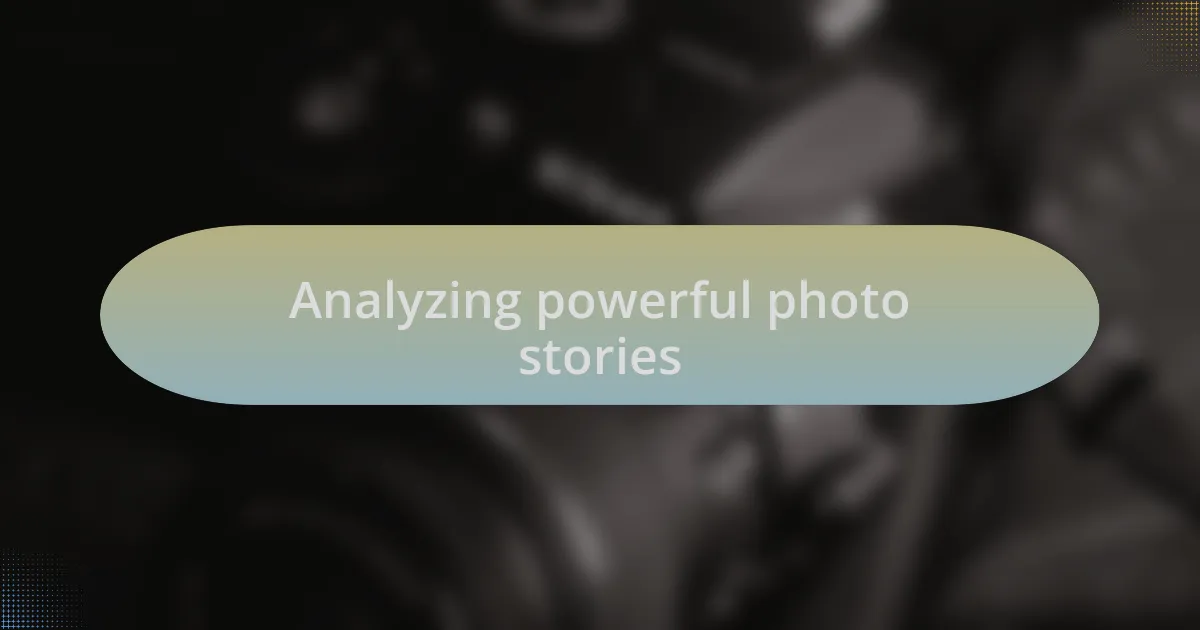
Analyzing powerful photo stories
Each powerful photo story has the ability to convey a narrative that resonates deeply with viewers. I recall a project I undertook documenting a local theater group’s rehearsal. As I captured the actors lost in their roles, it struck me how their expressions told unique stories of ambition, fear, and joy, each frame a piece of the larger tapestry of creativity. Have you ever noticed how a single image can encapsulate an entire life’s journey?
Analyzing these images often reveals layers of meaning that might not be immediately apparent. I remember returning to a poignant photograph I took of a woman gazing out of a rain-soaked window, lost in thought. At first glance, it seemed like a simple shot, but upon closer inspection, I could almost feel her longing and isolation. It made me realize how context—like weather or setting—can amplify the emotions captured in a photograph.
Additionally, the sequence of images in a photo story can create a compelling narrative arc. When I created a series on urban life, I started with a bustling street scene, gradually narrowing down to solitary moments of individuals reflecting amid the chaos. This progression encouraged viewers to feel the pulse of the city while inviting them to contemplate personal stories within its maze. How do you think rhythm and flow can impact the way we experience a photo story?
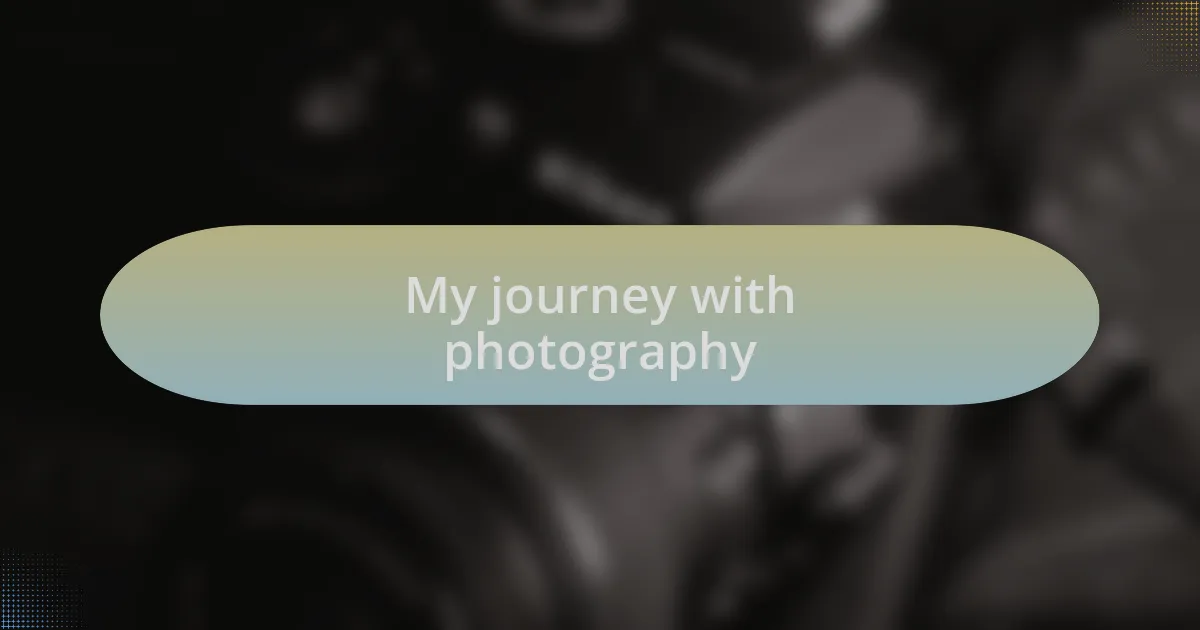
My journey with photography
My journey with photography began quite unexpectedly during a family gathering. Armed with a simple point-and-shoot camera, I aimed to capture candid moments, but what struck me was the thrill of freezing time. I still remember the laughter of my niece as she chased bubbles in the summer sun. In that fleeting moment, I saw how a photograph could hold an entire narrative of joy encapsulated in a single frame.
As I delved deeper into photography, I started to understand the nuances of light and composition, which transformed my perspective. One evening, while photographing the golden hour at a local park, I noticed a couple sharing a quiet moment on a bench. The way the soft light illuminated their faces revealed subtle emotions that I hadn’t captured before. This experience ignited a passion for storytelling through visuals, making me realize that every subject has a story waiting to be told.
Later, I ventured into exploring cultural events in my community. Capturing vibrant festivals, I found that each image was rich with layers—tradition, celebration, and belonging. I remember one particularly captivating moment when a dancer’s expression conveyed joy and pride as she twirled in her colorful attire. It made me wonder, how can we use our photos to celebrate diverse stories and foster understanding among us?
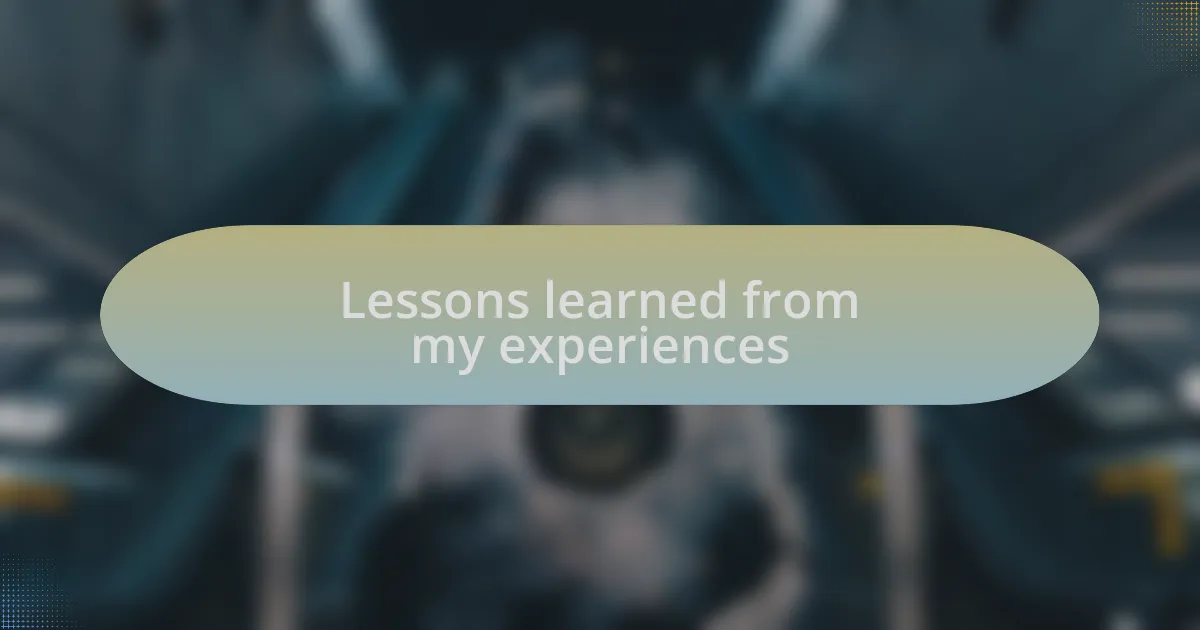
Lessons learned from my experiences
The most significant lesson I’ve learned is the importance of patience. During a sunset shoot at a beach, I found myself waiting for the perfect moment as the colors danced across the sky. In that quiet stillness, I realized that sometimes the best stories unfold slowly, and the act of waiting can lead to stunning visual narratives that might otherwise be missed.
Another crucial insight is the power of perspective. One day, while photographing my dog playing in the backyard, I decided to get down to his level, capturing his exuberance from an entirely different angle. This shift not only transformed the composition but also allowed me to connect with the pure joy in his eyes. It made me think: how often do we miss the real essence of a story because we’re stuck in our own viewpoint?
Lastly, I’ve come to appreciate the emotional resonance that a photograph can carry. I still remember an encounter with a stranger who shared her story of loss as I took her portrait in a bustling marketplace. It struck me how a single image could convey so much depth and feeling, prompting me to ask myself: how can I ensure that every shot I take speaks to the viewer’s heart? This reflection drives me to seek emotional truth in every frame I capture.